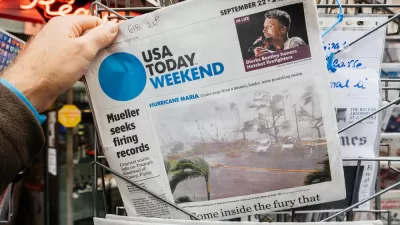Living off the grid usually refers to a lifestyle choice to live far from power lines and other basic infrastructure that most of civilization takes for granted—until a natural disaster wipes it all out.
Hurricane Maria scored a direct hit on the island of 3.4 million American residents on Sept. 20 as a category 4 storm with 155 mph winds, killing 34 people as of Oct. 3.
The "near total destruction of the commonwealth’s electric power grid has transformed Puerto Rico into Generator Island," report Richard Fausset, Frances Robles and Deborah Acosta for the New York Times on Oct. 6.
Running on gas or diesel, and ranging from lawn mower to moving-truck size, the generators are the only option for the roughly 90 percent of the island that has no access to the decimated grid. Generators now power big-box stores, high-rise apartment buildings, auto shops, fast-food restaurants, wastewater treatment plants and little country homes.
Sadly, President Trump was unaware that the island was without grid power during his Oct. 3 visit to San Juan, the nation's capital and largest city, evidenced by his telling residents as he handed out flashlights, "You don't need them anymore." He then proceeded to toss 'beautiful, soft' paper towels to the crowd.
"The storm destroyed 85 percent of the island’s energy transmission and distribution system, and the fix could cost $5 billion, said Ricardo Ramos, chief executive of the beleaguered Puerto Rico Electric Power Authority (PREPA)," add Fausset, Robles and Acosta for The Times.
In a news conference on [Oct. 6], Mr. Rosselló could not say when the system, which was infamously fragile before the storm, would be fully restored.
“There is no estimated date right now,” he said. “We have established, right at the beginning of this week, we want to have 10 percent of the energy generation in Puerto Rico. Now we’re up to 10.6 percent. And our expectation is, within the next month, to have 25 percent.
The electricity coverage had edged up to 11.7 percent as of Oct. 8, according to the commonwealth's new infrastructure website.
According to Andy Techmanski, chief executive of Montana-based Whitefish Energy Holdings, the company that PREPA contracted to restore service, "it would take six months or longer for all of Puerto Rico to have its power restored."
An earlier post indicated that power generation had survived largely intact. According to the U.S. Energy Information Administration, last year "47% of Puerto Rico’s electricity came from petroleum, 34% from natural gas, 17% from coal, and 2% from renewable energy." [See Wikipedia for a more precise breakdown].
A prior post may have left the impression that the Army Corps. of Engineers was rebuilding the grid. The Times clarifies the corps.' role:
Across the island, the Army Corps of Engineers has set up 34 huge generators so far, running everything from police departments to water pumping facilities to a [PREPA] office, according to Lisa Hunter, a spokeswoman for the Corps. Corps officials said on [Oct. 6] that 177 other generators arrived late in the week, with some of them headed to the United States Virgin Islands.
The generators pose public health problems, most notably because of their emissions, which include toxic carbon monoxide. The Puerto Rico Chapter of the Sierra Club also notes noise complaints, and that the presence of generators highlights disparities in wealth, evidenced by which houses are dark or lit at night.
FULL STORY: Minus Electrical Grid, Puerto Rico Becomes Generator Island

Alabama: Trump Terminates Settlements for Black Communities Harmed By Raw Sewage
Trump deemed the landmark civil rights agreement “illegal DEI and environmental justice policy.”

Study: Maui’s Plan to Convert Vacation Rentals to Long-Term Housing Could Cause Nearly $1 Billion Economic Loss
The plan would reduce visitor accommodation by 25% resulting in 1,900 jobs lost.

Planetizen Federal Action Tracker
A weekly monitor of how Trump’s orders and actions are impacting planners and planning in America.

Wind Energy on the Rise Despite Federal Policy Reversal
The Trump administration is revoking federal support for renewable energy, but demand for new projects continues unabated.

Passengers Flock to Caltrain After Electrification
The new electric trains are running faster and more reliably, leading to strong ridership growth on the Bay Area rail system.

Texas Churches Rally Behind ‘Yes in God’s Back Yard’ Legislation
Religious leaders want the state to reduce zoning regulations to streamline leasing church-owned land to housing developers.
Urban Design for Planners 1: Software Tools
This six-course series explores essential urban design concepts using open source software and equips planners with the tools they need to participate fully in the urban design process.
Planning for Universal Design
Learn the tools for implementing Universal Design in planning regulations.
Caltrans
Smith Gee Studio
Institute for Housing and Urban Development Studies (IHS)
City of Grandview
Harvard GSD Executive Education
Toledo-Lucas County Plan Commissions
Salt Lake City
NYU Wagner Graduate School of Public Service




























